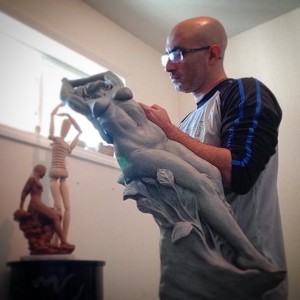The Journey of the Creative Mind
Art looks like a destination. Art looks like a journey. Art looks like both. There are many physical processes involved in the creation of art. The eyes, the hands, and body movements combine to develop what can be called ‘technique’. Technique is connected to the non-physical world of the mind. What are we thinking when we create? That is considering the premise that we need to be actively thinking in order to exist according to René Descartes’ “je pense, donc je suis” (I think, therefore I am). What are we feeling? Considering that we are also emotional beings and feelings are our connection to a physical world. What are the antecedents that provoke those things? That is accepting that we are influenced by something or someone triggering thoughts, feelings or ideas that are now materializing in our art. Are there ‘energies’ outside the physical brain motivating creativity? That is the concept of the ancient Greeks’ muses and the conception that inspiration comes from outside of us.
Humans are always trying to explain abstract ideas in a ‘concrete’ manner even though language itself is an abstraction. Moreover, I believe writing is not a way of making the idea concrete but a visual way to make it abstract. The idea becomes a sound and the sound received visual symbols we call ‘letters’ which consequently forms an alphabet. We form words with them providing a visualization of the idea. Cognitive psychology attempts to explain this phenomena. In instructional design we pay attention to learning concepts that help us design learning activities. Concepts as making sense, consciousness, perception, reflection, intention, action, and so on. Psychoanalysis, made famous by Sigmund Freud, explores what I am going to call ‘the dark side of the moon’. In psychoanalysis the focus is on what happens in a conscious state but in the unconscious mind. Concepts like subliminal messages, dreams, suppressed memories, instincts, and other factors that connects us to the conscious world with an unconscious root. Think of Salvador Dalí and surrealism.
We can try to explain or map the journey of the creative mind and we will always fall short of explaining its full ‘reality’. We can take a piece of art as a destination and trace back the steps to the beginning of time in an attempt to explain creativity by its result. I will argue that the artwork is not the result or the destination of the creative mind more mostly a souvenir from the trip like that card, t-shirt, or the famous coffee mug we get as a memory. Creativity is much more powerful than its result. There might be more happening in the subconscious mind than what is happening in the conscious mind when art is created. The journey of the creative mind is not to be fully explained or understood but to be enjoyed and experienced. It is what we talk about to entertain ourselves with the possibilities and not to prove a point. We just enjoy the trip, the memories, and the souvenirs.


The Reality in Myth
Thessalonike of Macedon was a princess. According to myth, a mermaid will surface to encounter sailors on their way to Macedon asking, “Is Alexander the king alive?” To this question there was only one appropriate answer that will allow the sailors to continue their way, “He lives and reigns and conquers the world.” Any other answer will enrage the mermaid and transform her into the monster Gorgon which drowned the ships and the sailors. The myth says that the mermaid is no other than Thessalonike, sister of Alexander the great who in her attempt to kill herself threw herself into the sea but instead of drowning, she was transformed into a mermaid.
One of my favorite stories of greek mythology is the story of king Minos and the minotaur. It is one of the most bizarre stories ever told in ancient Greece. The Greeks tried to depict their disgust to the practices of the Minoans that the story is nothing but a description of a barbarian nation. After all, for them either you were greek or barbarian. Same with the Romans, it was either Roman or barbarian. Many people think like that still today. People constantly judge others because they don’t believe the same, or practice the same, or share their lineage, language, or nationality. People still today create myths to degrade others mixing some reality with it to try to make it believable. Maybe on the other side others are doing the same with them.